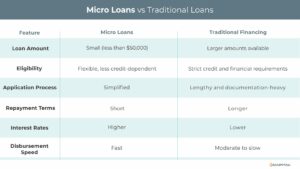
Empowering Small Businesses: The Impact of Micro Loans
Content
- What Are Micro Loans?
- Key Features of Micro Loans:
- How Micro Loans Work
- Who Benefits From Micro Loans?
- Advantages of Micro Loans
- Challenges of Micro Loans
- Industries That Benefit From Micro Loans
- Real-World Example: Micro Loans in Action
- How to Choose the Right Micro Loan
- The Future of Micro Loans
- Conclusion
- Key Takeaways
Access to funding can often be the biggest hurdle to growth. This is particularly true for startups and small businesses because they typically lack the financial history, collateral, or creditworthiness required to secure traditional loans. A lack of accessible funds often limits their ability to invest in expansion, innovation, or operational improvements. Micro loans offer a powerful solution, providing smaller amounts of capital with more accessible terms than traditional lending options.
Whether it’s to launch a new venture, invest in equipment, or manage day-to-day operations, this type of financing is making a big impact on small businesses worldwide. In this blog, we’ll explore micro loans, how they work, and why they’re a vital resource for businesses aiming to scale.
What Are Micro Loans?
Micro loans are small, short-term loans designed to meet the financial needs of small businesses, startups, and individual entrepreneurs. Typically ranging from a few hundred to tens of thousands of dollars, this type of financing often serve those who may not qualify for traditional bank loans due to limited credit history, collateral, or scale of operations.
Key Features of Micro Loans:
- Smaller Loan Amounts: These are usually under $50,000, making them ideal for smaller funding needs.
- Flexible Eligibility: Designed for startups, minority-owned businesses, and underserved entrepreneurs.
- Short Repayment Terms: Repayment periods typically range from six months to five years.
- Accessible Providers: Offered by microfinance institutions, non-profits, and alternative lenders.
How Micro Loans Work
- Application: Borrowers submit a loan application, often with fewer requirements than traditional loans. Providers may focus on business plans, revenue projections, and community impact.
- Approval: Micro lenders assess the borrower’s ability to repay, considering non-traditional credit factors like character, community involvement, and cash flow.
- Disbursement: Once approved, funds are disbursed quickly, often within days.
- Repayment: Borrowers make regular repayments, which may include interest, until the loan is fully paid.
Who Benefits From Micro Loans?
Micro loans cater to specific groups who might face challenges accessing traditional financing:
- Startups: Entrepreneurs needing initial capital for inventory, equipment, or working capital.
- Small Business Owners: Companies with modest funding needs for expansion or operational improvements.
- Minority and Women-Owned Businesses: Entrepreneurs from underrepresented groups who may lack access to traditional banking services.
Advantages of Micro Loans
- Accessible Funding
- Micro loans are designed to serve those who traditional lenders often overlook, including new businesses and individuals with limited credit history.
- Flexible Terms
- These loans often feature lower qualification barriers, customized repayment plans, and negotiable terms.
- Community Support
- Many micro lenders operate as part of community initiatives, focusing on the social and economic impact of their loans.
- Quick Disbursement
- Unlike traditional loans, which can take weeks or months, this type of financing is often processed and approved quickly.
- Building Credit
- For borrowers with limited credit history, timely repayment of this type of financing can help establish or improve credit scores.
Challenges of Micro Loans
- Higher Interest Rates
- Due to smaller loan amounts and higher risk, interest rates on micro loans can be higher than on traditional loans.
- Limited Funding Amounts
- Businesses with larger funding needs may find this type of financing insufficient for major projects or expansions.
- Short Repayment Terms
- While shorter repayment periods can reduce interest costs, they may strain cash flow for some businesses.
- Variable Quality of Lenders
- Not all micro lenders operate with transparency; borrowers should carefully vet lenders to avoid inadequate financing, poorly structured facilities, or fraud. Look for a reputable lender by checking reviews, case examples, and the lender’s credentials.
Industries That Benefit From Micro Loans
- Retail and E-Commerce: Small retailers use this type of financing to purchase inventory or improve storefronts.
- Food and Beverage: Entrepreneurs launch food trucks, cafés, or catering businesses with micro funding.
- Artisans and Craftspeople: Funding helps cover the costs of raw materials, tools, and marketing.
- Agriculture: Farmers use this type of financing to invest in equipment, seeds, and sustainable practices.
- Service-Based Businesses: This type of financing enable businesses like salons, consulting firms, or repair services to get off the ground.
Real-World Example: Micro Loans in Action
Scenario: A budding entrepreneur dreams of starting a mobile coffee truck but lacks the funds to purchase equipment and initial inventory.
Solution: The entrepreneur applies for a $10,000 micro loan from a community-based lender. The funds are used to buy a truck, coffee machines, and supplies.
Outcome: Within six months, the mobile coffee truck becomes a local favorite, generating enough revenue to cover loan repayments while allowing the owner to save for future expansion.
How to Choose the Right Micro Loan
- Research Lenders
- Look for reputable microfinance institutions or non-profits with clear terms and community-focused missions.
- Understand Costs
- Carefully review interest rates, fees, and repayment schedules to ensure affordability.
- Prepare a Business Plan
- A solid business plan can increase approval chances and help lenders understand your goals.
- Evaluate Impact
- Consider how the loan will directly contribute to your business’s success and sustainability.
The Future of Micro Loans
With advancements in financial technology, this type of financing is becoming even more accessible through online platforms and mobile apps. These innovations are expanding reach, particularly for underserved communities, while reducing processing times and costs.
Conclusion
Micro loans are more than just financial tools; they’re catalysts for growth, empowerment, and economic development. For small businesses and entrepreneurs with big dreams but limited resources, this type of financing offers a vital pathway to success.
Whether you’re starting a business, funding a small expansion, or bridging short-term cash flow gaps, a micro loan could be the key to unlocking your potential. Research your options, choose a trusted lender, and take the first step toward turning your vision into reality.
Key Takeaways
- Startups and small businesses typically lack the financial history, collateral, or creditworthiness required to secure traditional loans. This often limits their ability to invest in expansion, innovation, or operational improvements.
- Whether starting a business, funding a small expansion, or bridging short-term cash flow gaps, a micro loan could be the key to unlocking your potential.
- These loans often feature lower qualification barriers, customized repayment plans, and negotiable terms.
ABOUT eCapital
At eCapital, we accelerate business growth by delivering fast, flexible access to capital through cutting-edge technology and deep industry insight.
Across North America and the U.K., we’ve redefined how small and medium-sized businesses access funding—eliminating friction, speeding approvals, and empowering clients with access to the capital they need to move forward. With the capacity to fund facilities from $5 million to $250 million, we support a wide range of business needs at every stage.
With a powerful blend of innovation, scalability, and personalized service, we’re not just a funding provider, we’re a strategic partner built for what’s next.



